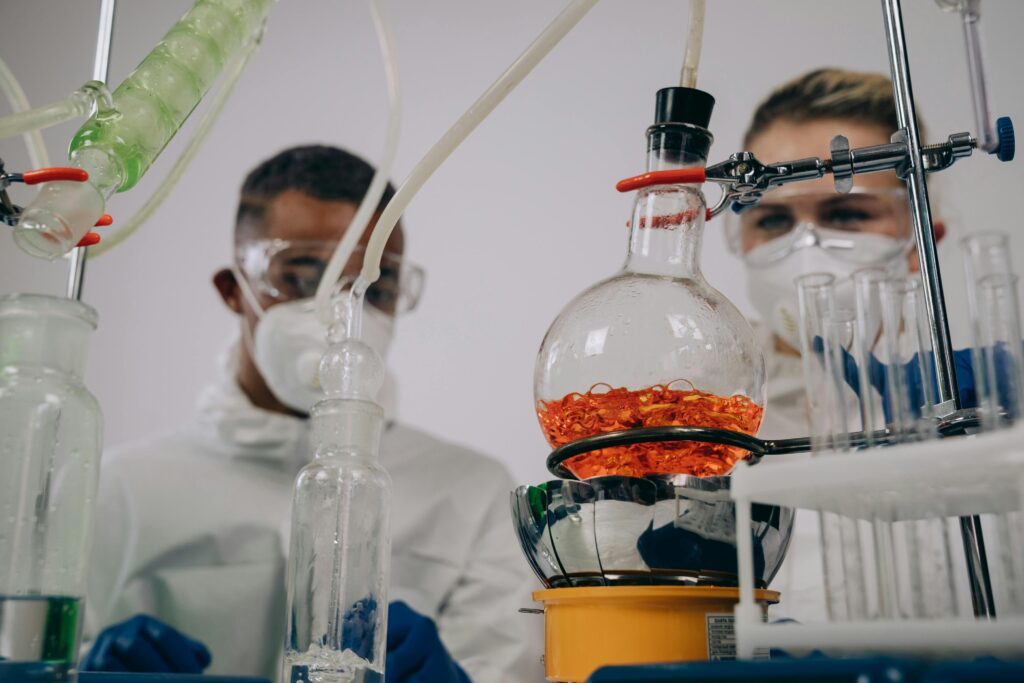Maruti Fine Chemicals is a leading provider of specialty chemicals catering to various industries. Among its range of products are three significant acids: Fuming Sulfuric Acid, Fuming Sulphuric Acid, and Hydrochloric Acid. These acids find applications in diverse fields, from industrial processes to laboratory experiments. Let’s delve deeper into each of these chemicals.
Strong acids are substances that completely dissociate in water to form hydrogen ions (H⁺). They are known for their corrosive nature and ability to react vigorously with other substances. In this blog post, we’ll delve into three powerful acids: fuming sulfuric acid, fuming sulphuric acid, and hydrochloric acid.
What is Fuming Sulfuric Acid?
Fuming Sulfuric Acid, also known as Oleum or Sulfuric Acid, is a highly corrosive and dangerous chemical compound. It is a concentrated form of sulfuric acid with added sulfur trioxide, resulting in a solution with a higher concentration of SO3.
Understanding Fuming Sulfuric Acid
Definition: Fuming sulfuric acid, also known as oleum or Nordhausen acid, is a highly corrosive and oily liquid. It is a solution of sulfur trioxide in concentrated sulfuric acid.
Properties: Fuming sulfuric acid is characterized by its fuming nature due to the presence of sulfur trioxide. It has a high affinity for water and releases heat when mixed with it. Additionally, it is highly reactive and can cause severe burns upon contact with skin.
Applications: Fuming sulfuric acid is commonly used in the production of explosives, dyes, and pharmaceuticals. It serves as a powerful dehydrating agent and catalyst in various chemical reactions.
Properties of Fuming Sulfuric Acid:
Corrosive: Fuming Sulfuric Acid can cause severe burns upon contact with skin and eyes.
Fuming: It emits toxic fumes of sulfuric acid and sulfur trioxide, hence the name “fuming.”
High Reactivity: It is highly reactive with water and organic materials, making it useful in various chemical reactions.
Safety Precautions:
Handling should be done in a well-ventilated area with proper protective equipment, including gloves, goggles, and a lab coat.
It should be stored away from water and incompatible substances.

Fuming Sulphuric Acid
Understanding Fuming Sulphuric Acid:
Fuming Sulphuric Acid is essentially the same as Fuming Sulfuric Acid, differing only in spelling due to regional variations in English. Both terms refer to the same chemical compound.
Exploring Fuming Sulphuric Acid
Definition: Fuming sulphuric acid is similar to fuming sulfuric acid but with a different spelling convention. It possesses similar properties and applications.
Properties: Fuming sulphuric acid shares the fuming characteristic with fuming sulfuric acid due to the presence of sulfur trioxide. It exhibits high reactivity and should be handled with extreme caution.
Applications: Similar to fuming sulfuric acid, fuming sulphuric acid finds applications in various industries, including the production of chemicals, dyes, and pharmaceuticals.
Why “Fuming” Sulphuric Acid?
The term “fuming” indicates the release of fumes or vapors when the acid comes into contact with air. These fumes consist of sulfuric acid and sulfur trioxide, which can be hazardous if inhaled.
Handling and Safety:
Safety precautions and handling methods for Fuming Sulphuric Acid mirror those for Fuming Sulfuric Acid.
Insights into Hydrochloric Acid
Definition: Hydrochloric acid is a strong, colorless, and highly corrosive acid. It is a solution of hydrogen chloride (HCl) gas in water.
Properties: Hydrochloric acid is known for its pungent odor and ability to dissolve many metals. It is highly reactive and can cause severe burns upon contact. In diluted form, it is commonly known as muriatic acid.
Applications: Hydrochloric acid is widely used in metal cleaning, food processing, and chemical synthesis. It is also employed in the production of various industrial chemicals.

- FAQs
Q1: What precautions should be taken when handling fuming sulfuric acid and fuming sulphuric acid?
A1: When handling fuming sulfuric acid or fuming sulphuric acid, it is essential to wear appropriate protective gear, including gloves, goggles, and a lab coat. These acids should only be used in a well-ventilated area, and contact with skin or eyes should be avoided at all costs.
Q2: Can fuming sulfuric acid and fuming sulphuric acid be stored safely?
A2: Due to their highly reactive nature, fuming sulfuric acid and fuming sulphuric acid should be stored in tightly sealed containers made of inert materials such as glass or certain plastics. They should be kept away from moisture and incompatible substances to prevent accidents.
Q3: What are the hazards associated with hydrochloric acid?
A3: Hydrochloric acid poses several hazards, including corrosion of skin, eyes, and respiratory tract upon contact. It can also release toxic fumes when heated, posing a risk to health. Proper ventilation and protective equipment should be used when working with hydrochloric acid.
Conclusion
In conclusion, fuming sulfuric acid, fuming sulphuric acid, and hydrochloric acid are powerful acids with diverse applications across various industries. While they offer immense utility in chemical synthesis and industrial processes, their handling requires careful attention and adherence to safety protocols. By understanding their properties and applications, professionals in the chemical industry can harness the power of these acids while minimizing risks to health and safety. At Maruti Fine Chemicals, we prioritize safety and provide high-quality acids for our customers’ diverse needs.
